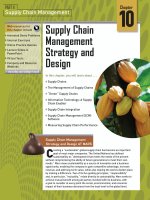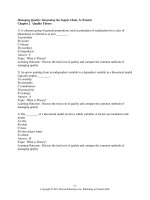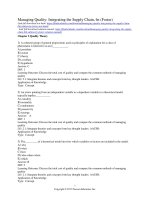Lecture Operations management: Creating value along the supply chain (Canadian edition) - Chapter 4
Bạn đang xem bản rút gọn của tài liệu. Xem và tải ngay bản đầy đủ của tài liệu tại đây (1.13 MB, 44 trang )
OPERATIONS MANAGEMENT:
Creating Value Along the Supply Chain,
Canadian Edition
Robert S. Russell, Bernard W. Taylor III, Ignacio Castillo, Navneet Vidyarthi
CHAPTER 4
Product Design
Learning Objectives
Provide an overview of each step of the product design process
and describe the three types of concurrent designs.
Discuss several computer aided systems available for the
design of new products and their related production processes.
Use two techniques for analyzing design failures and one
technique for eliminating unnecessary design features.
Explain why and how each step of the product lifecycle can be
changed for improved environmental stewardship and provide
examples of programs that support green efforts.
Use quality function deployment as a design tool.
Lecture Outline
Design Process
Rapid Prototyping and Concurrent Design
Technology in Design
Design Quality Reviews
Design for Environment
Quality Function Deployment
Design for Robustness
Design Process
Effective design can provide a competitive edge
matches product or service characteristics with customer
requirements
ensures that customer requirements are met in the
simplest and least costly manner
reduces time required to design a new product or service
minimizes revisions necessary to make a design
workable
Design Process
Product design
defines appearance of product
sets standards for performance
specifies which materials are to be used
determines dimensions and tolerances
Design Process
Idea Generation
Company’s own R&D
Salespersons in the
department
field
Customer complaints or Factory workers
suggestions
New technological
Marketing research
developments
Suppliers
Competitors
Idea Generation
Perceptual Maps
visual comparison of customer perceptions
Benchmarking
comparing product/process against best-in-class
Reverse engineering
dismantling competitor’s product to improve your own
product
Perceptual Map of Breakfast Cereals
Feasibility Study
Market analysis
Economic analysis
Technical/strategic analyses
Performance specifications
Rapid Prototyping and
Concurrent Design
Testing and revising a preliminary design model
Build a prototype
form design
functional design
production design
Test prototype
Revise design
Retest
Concurrent Design
Form and Functional Design
Form Design
• how product will look?
Functional Design
• how product will perform?
•
reliability
•
maintainability
•
usability
Computing Reliability
Computing Reliability
System Reliability
0.90
0.98
0.98
0.92
0.98
0.92+(1-0.92)(0.90)=0.99
0.98 x 0.99 x 0.98 = 0.951
0.98
System Availability (SA)
SA =
MTBF
MTBF + MTTR
where:
MTBF = mean time between failures
MTTR = mean time to repair
System Availability
PROVIDER
MTBF (HR)
MTTR (HR)
A
B
C
60
36
24
4.0
2.0
1.0
SAA = 60 / (60 + 4) = .9375 or 94%
SAB = 36 / (36 + 2) = .9473 or 95%
SAC = 24 / (24 + 1) = .96 or 96%
Usability
Ease of use of a product or service
ease of learning
ease of use
ease of remembering how to use
frequency and severity of errors
user satisfaction with experience
Production Design
How the product will be made
Simplification
•
reducing number of parts, assemblies, or options in a product
Standardization
•
using commonly available and interchangeable parts
Modular Design
•
combining standardized building blocks, or modules, to create
unique finished products
Design for Manufacture (DFM)
•
Designing a product so that it can be produced easily and
economically
Design Simplification
Final Design and Process Plans
Final design
detailed drawings and specifications for new product or
service
Process plans
workable instructions
•
necessary equipment and tooling
•
component sourcing recommendations
•
job descriptions and procedures
•
computer programs for automated machines
Technology in Design
Computer Aided Design (CAD)
assists in creation, modification, and analysis of a design
computer-aided engineering (CAE)
•
tests and analyzes designs on computer screen
computer-aided manufacturing (CAD/CAM)
•
ultimate design-to-manufacture connection
product life cycle management (PLM)
•
managing entire lifecycle of a product
collaborative product design (CPD)
Collaborative Product Design (CPD)
A software system for collaborative design and
development among trading partners
With PML, manages product data, sets up project
workspaces, and follows life cycle of the product
Accelerates product development, helps to resolve product
launch issues, and improves quality of design
Designers can
conduct virtual review sessions
test “what if” scenarios
assign and track design issues
communicate with multiple tiers of suppliers
create, store, and manage project documents
Design Quality Review
Review designs to prevent failures and ensure
value
Failure mode and effects analysis (FMEA)
•
a systematic method of analyzing product failures
Fault tree analysis (FTA)
•
a visual method for analyzing interrelationships among failures
Value analysis (VA)
•
helps eliminate unnecessary features and functions









